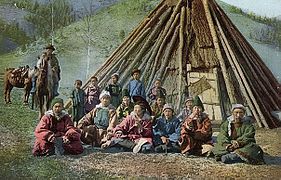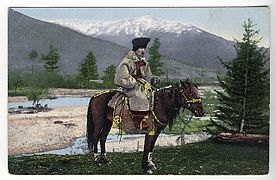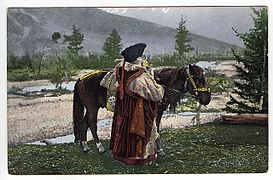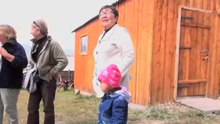Altai people
 Altay ethnic flag, adopted by Russia as the official flag of the Altai Republic. | |
| Regions with significant populations | |
|---|---|
| 74,238[1] |
| Languages | |
Altay, Russian | |
| Religion | |
Shamanism, Burkhanism, Russian Orthodox | |
| Related ethnic groups | |
| other Turkic people | |
The Altay or Altai are a Turkic people living in the Siberian Altai Republic and Altai Krai. For alternative ethnonyms see also Teleut, Tele, Telengit, Black Tatar, and Oirats. The Altaians are presented by two ethnographic groups:
- The Northern Altaians include the Tubalar (the Tuba-Kizhi), the Chelkans, the Kumandin, the Shors
- The Southern Altaians include the Altaian (the Altai-Kizhi), the Teleut, the Teles, the Telengit
The Northern and Southern Altayans formed in the Altay area on the basis of tribes of Kimek-Kipchaks.[2][3]
Contents
1 History
2 Demographics
3 See also
4 Notes
5 External links
History
The Altaians were annexed by the Four Oirat of Western Mongols in the 16th century. The Mongols called them "Telengid" or "Telengid aimag" in period of the Northern Yuan dynasty. After the fall of the Zunghar Khanate in the 18th century, the Altaians were subjugated by the Qing Dynasty. That court referred to them as Altan Nuur Uriyangkhai.[4] But Altaians are not genetically related to the Uriyangkhai, which is a distinct neighbouring Oirat-Mongol ethnic group in Mongolia.
The Altay came into contact with Russians in the 18th century. In the tsarist period, the Altay were known as oirot or oyrot (this name means oirat and would later be carried on for the Oyrot Autonomous Oblast). The Altay report that many of them became addicted to the Russians' vodka, which they called "fire water".[5]
In regard to religion, some of the Altay remain Shamanists, while others (in a trend beginning in the mid-19th century) have converted to the Russian Orthodox Church. The Altai mission was developed under Saint Makarii Glukharev († 1847), known as the 'Apostle to the Altai'.[citation needed] In 1904, a religious movement called Ak Jang or Burkhanism arose among these people.[6]
Prior to 1917 the Altai were considered to be made up of many different ethnic groups.[7]
With the rise of the 1917 revolution, the Altay attempted to make their region a separate Burkhanist republic called Oyrot. Their support for the Mensheviks during the Civil War led to the venture's collapse after the Bolshevik victory and the later rise of Joseph Stalin. In the 1940s, during World War II and when he was directing numerous purges, his government declared the Altay of being pro-Japanese. The word "oyrot" was declared to be counterrevolutionary. By 1950, Soviet industrialization policies and development in this area resulted in considerable migration of Russians to this republic, reducing the proportion of Altay in the total population from 50% to 20%.[8] In the early 21st century, ethnic Altaians make up about 31% of the Altai Republic's population.[9]

Altai people

Altay shaman

Altay man in national suit on horse

Altay woman in national dress

Altaian horseman

Altaian woman
Demographics
 Play media
Play mediaA VOA reporter tours the Altai region in 2012.
According to the 2010 Russian census, there was a total of 69,963 Altaians who resided within the Altai Republic. This represented 34.5% of the total population of the republic, compared with 56.6% with a Russian background, Altaian families are the majority only in certain villages. However, Altaian culture is still the local culture between people and communities.
See also
- Altay language
- Altay Mountains
- Altai Republic
- Altay Prefecture
- Govi-Altai Province
- Altay Airport
- Altay City
Notes
^ Russian Census 2010: Population by ethnicity Archived 2012-04-24 at the Wayback Machine. (in Russian)
^ Ethnic history, History of a region, Statistic information at http://eng.altai-republic.ru/index.php Archived 2011-07-17 at the Wayback Machine.
^ NUPI Centre for Russian Studies http://www2.nupi.no/cgi-win//Russland/etnisk_b.exe?Altai
^ C.P.Atwood- Encyclopedia of Mongolia and the Mongol Empire, p.9
^ "People from Russia — Interviews on the Streets", Way To Russia, 24 September 2003
^ Znamenski, Andrei A. (2014-06-30). "Power for the Powerless : Oirot/Amursana Prophecy in Altai and Western Mongolia, 1890s-1920s". Études mongoles et sibériennes, centrasiatiques et tibétaines (45). doi:10.4000/emscat.2444. ISSN 0766-5075..mw-parser-output cite.citationfont-style:inherit.mw-parser-output qquotes:"""""""'""'".mw-parser-output code.cs1-codecolor:inherit;background:inherit;border:inherit;padding:inherit.mw-parser-output .cs1-lock-free abackground:url("//upload.wikimedia.org/wikipedia/commons/thumb/6/65/Lock-green.svg/9px-Lock-green.svg.png")no-repeat;background-position:right .1em center.mw-parser-output .cs1-lock-limited a,.mw-parser-output .cs1-lock-registration abackground:url("//upload.wikimedia.org/wikipedia/commons/thumb/d/d6/Lock-gray-alt-2.svg/9px-Lock-gray-alt-2.svg.png")no-repeat;background-position:right .1em center.mw-parser-output .cs1-lock-subscription abackground:url("//upload.wikimedia.org/wikipedia/commons/thumb/a/aa/Lock-red-alt-2.svg/9px-Lock-red-alt-2.svg.png")no-repeat;background-position:right .1em center.mw-parser-output .cs1-subscription,.mw-parser-output .cs1-registrationcolor:#555.mw-parser-output .cs1-subscription span,.mw-parser-output .cs1-registration spanborder-bottom:1px dotted;cursor:help.mw-parser-output .cs1-hidden-errordisplay:none;font-size:100%.mw-parser-output .cs1-visible-errorfont-size:100%.mw-parser-output .cs1-subscription,.mw-parser-output .cs1-registration,.mw-parser-output .cs1-formatfont-size:95%.mw-parser-output .cs1-kern-left,.mw-parser-output .cs1-kern-wl-leftpadding-left:0.2em.mw-parser-output .cs1-kern-right,.mw-parser-output .cs1-kern-wl-rightpadding-right:0.2em
^ Kolga et al., The Red Book of the Peoples of the Russian Empire, p. 29
^ "Altay" Archived 2006-04-24 at the Wayback Machine., Centre for Russian Studies, NUPI, retrieved 17 October 2006
^ "Altai Republic :: official portal". Archived from the original on 2006-08-13. Retrieved 2006-10-24.
External links
- NUPI - Centre for Russian Studies profile
- The legend of Altay





